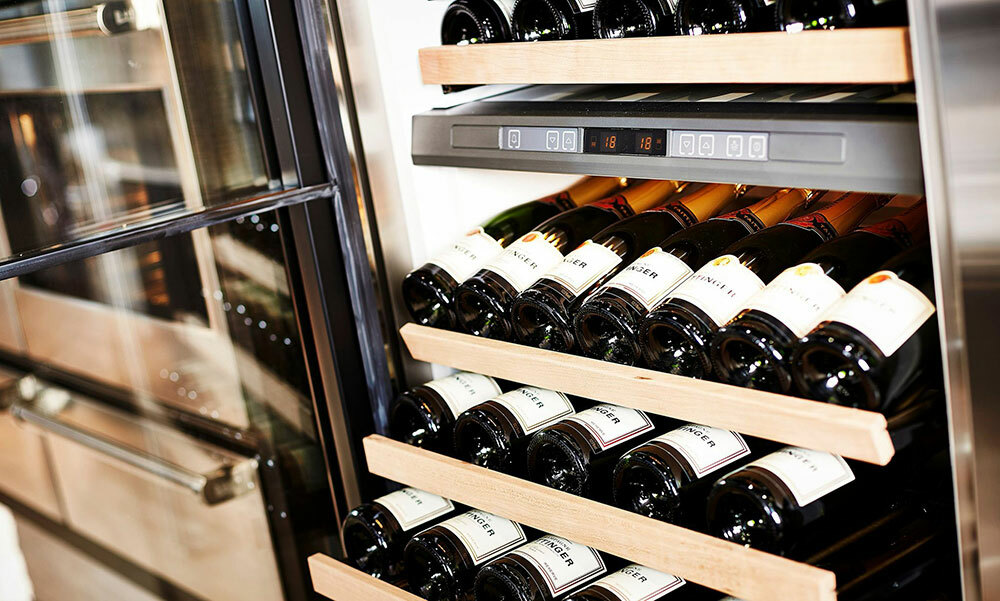Wine consumption has remained strong since the outbreak of the pandemic, fuelled by lockdowns and more drinking outside of mealtimes, according to recent research by Wine Intelligence.
Whether you are adding a few extra bottles to your on-line groceries or ordering fine wines from specialist merchants, investing in wine storage will keep it at the optimum temperature for serving or maturing.
“You don’t need to be that serious about wine to buy a cabinet. Smaller units are handy, so you don’t have to fill your fridge with wine bottles, while a 312 bottle capacity is aimed at someone who loves collecting and tasting good wines – and they are quickly becoming a design feature too,” says Callum Dooley, director of Elite Wine Refrigeration, which specialises in wine coolers and cabinets.
Give some thought to how many bottles you need to store; whether you prefer your wine on display or hidden from view; and where you plan to position it. Check decibel levels if you are buying a freestanding cooler for the living or dining room, or ask if a silencer can be fitted.
Customers should think about bottle capacity, the shape and size of bottles they plan to store, the type of installation (freestanding, integrated, built-in or installed in a garage, etc) and their budget,” adds Mr Dooley. “There is a whole range of units available on the market from good to shockingly bad quality.”
Wine storage encompasses anything from coolers or serving cabinets to chill your wine before serving – to wine cabinets designed to store larger quantities for longer periods, with the aim of creating a cellar-like environment.

Wine cabinets should offer a constant temperature of 12°C and ideally a solid door with no light (or a UV-resistant glass door), humidity control and anti-vibration features that protect wine from being disturbed.
But many of the high-end wine storage or wine conditioning units you’ll find today lie somewhere in between with two or more temperature zones for both chilling and maturing wines.


Stay Chilled
If you’re buying wine purely for entertaining, then still look out for models where you can set the right temperature and humidity levels, with a UV-filtered glass door and a silent compressor to avoid vibrations that can disturb wine bottles.
Avoid cheap coolers, which may have shelving designed for bottles but don’t necessarily offer the features that help to protect wine.
When it comes to setting the right temperature, leading brand Sub-Zero says it’s really down to individual tastes, but as a guide suggests around 4°C or 5°C for whites and champagnes and around 18°C for red wines.
Humidity should also be moderate, as if it is too high, mould can grow and wine labels may deteriorate. If it is too low, corks can dry out, allowing air in – prematurely aging the wine and affecting its taste. As a rough guide, humidity levels should be between 50% and 70%.
Sunlight and UV rays can speed up a wine’s ageing process, affecting its taste, so look out for UV-protected glass or solid doors and LED lighting – but use this sparingly in the evening or when you have friends or family round.





Freestanding Wine Storage
Is Wine Storage Energy Efficient?
But it’s also about investing in good-quality products that are designed to last.
“To make this type of product more sustainable, manufacturers should be focusing on high-quality appliances rather than throw-away items”, adds Mr Dooley.
“The wine cooler market is saturated with units that are only designed to last one or two years, if that, then will be thrown away. If we only have to produce one unit per customer every 10 years, carbon emissions from the factories will come down substantially.”
So, the message is: aim for a top-quality product that is energy-efficient and built to last – and then you can sit back and enjoy a perfectly chilled glass of wine or build up your ‘mini-cellar’ of fine wines and watch your investment grow.
This is an edited version of the original article posted on www.wentworthlifestyle.com on 4th February 2021


